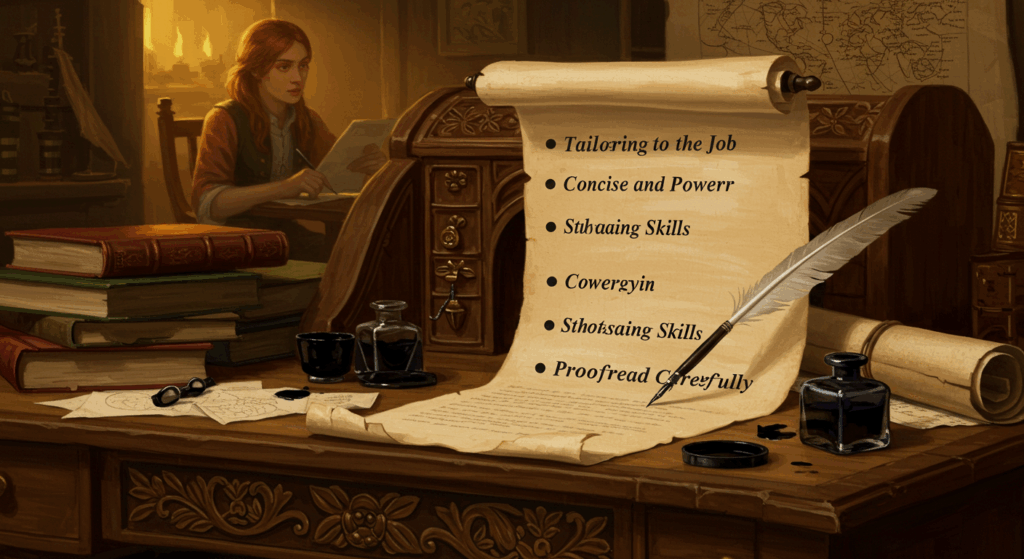If writing a cover letter makes you want to crawl under a blanket and binge a whole season of something comfy on Netflix… same. But also: we got this. A good cover letter isn’t a novel, it’s a highlight reel with a purpose. Think of it as your personal trailer: short, punchy, and tailored to the exact audience (aka the hiring manager) you want to impress. In this guide, I’ll walk you through a chill, step-by-step approach to making a cover letter that actually gets read—without sounding like a corporate robot. I’ll sprinkle in writing advice and formatting tips along the way, plus tiny mistakes to avoid so you don’t accidentally sabotage your own magic. Sound good? Let’s go.
Why Cover Letters Still Matter (Even Now)
You might hear “no one reads cover letters anymore.” Sometimes true. Often false. Here’s the thing—if your resume is the what, the cover letter is the why. It’s where you connect dots, show your voice, and prove you actually care about this role, not just any job with a paycheck. When a hiring manager is choosing between similar resumes, a thoughtful letter can be the tie-breaker. It’s like the difference between a generic Spotify playlist and that perfect vibe someone made just for you. Same songs? Maybe. But the context hits different.
The Step-by-Step Approach (Quick Peek)
Here’s the bird’s-eye view of our step-by-step approach before we zoom in:
- Read the job post like a detective.
- Choose your letter structure.
- Nail the formatting basics.
- Write a strong header and greeting.
- Open with a hook (no snooze starts).
- Prove you can do the job (wins + metrics).
- Connect your story to the company’s needs.
- Close with confidence and a clear next step.
- Tighten the writing (micro-edits that matter).
- Final checks: ATS, filename, PDF, links.
We’ll unpack each part with practical writing advice and simple formatting tips you can use immediately.
Step 1: Read the Job Post Like a Detective
Get weirdly curious. Read the posting 2–3 times and highlight:
- Top skills (hard + soft): tools, languages, systems, collab stuff.
- Business goals (hidden): growth? retention? faster delivery? brand lift?
- Keywords you should mirror (naturally).
- Signals about culture (fast-paced, mission-driven, scrappy).
Pro move: paste the posting into a doc and annotate it. Make “buckets” of what they care about. Your letter will speak to those buckets—not every single bullet (please don’t write a manifesto).
Step 2: Pick a Structure That Fits Your Story
Not all letters should look the same. Choose one format and commit:
The Classic (safe + clean)
- Intro: role you’re applying for + quick hook.
- Body: 1–2 short paragraphs with relevant wins.
- Close: value-focused sign-off + call to action.
The Problem–Action–Result (PAR) (impact-forward)
- Problem the company/team likely has.
- Action you’ve taken in similar situations.
- Result with numbers (or concrete outcomes).
The Story Snap (human + memorable)
- 3–4 sentences about a moment that shows your why, then connect it to the role.
The Hybrid (my fave)
- Hook + PAR bullet points + tailored close. Quick to skim, still human.
Choose the structure that makes your best stuff obvious. If the role is analytical, PAR wins. If it’s brand/design, Story or Hybrid might shine.
Step 3: Formatting Tips That Quietly Impress
Real talk: visuals matter. Don’t let sloppy layout ruin a solid pitch. Here are formatting tips that make you look instantly more polished:
- Length: 250–400 words (max one page). Shorter is usually better.
- Font: a clean sans (Arial, Calibri, Inter) or serif (Georgia). 10.5–12 pt.
- Margins: ~1″ all around. White space = breathable.
- Spacing: single-spaced with a blank line between paragraphs.
- Alignment: left align everything; no justified rivers of text.
- Header: your name, email, phone, portfolio/LinkedIn (hyperlink them).
- File: PDF unless the posting says otherwise.
- Filename:
FirstName-LastName-CoverLetter-Role-Company.pdf. No chaos.
These formatting tips are tiny but mighty—they make the screener’s life easier, which low-key helps you.
Step 4: Header + Greeting (Don’t Overthink, But Do Care)
At the top, mirror your resume header for consistency. Below it, add:
- Date
- Hiring Manager’s Name + Title (if you can find it)
- Company + Team/Dept
- Company Address (optional; fine to skip for startups)
Greeting:
- Best: “Hi <Name>,” or “Dear <Name>,”
- If no name: “Hi Hiring Team,” or “Dear Hiring Team,”
- Avoid: “To Whom It May Concern” (feels like 1997 and a fax machine).
Step 5: Open With a Hook (No Snooze Starts)
Your opening sets the tone. Skip “I’m writing to apply for…” (we know). Try:
- A quick connection: “As a long-time user of your app…”
- A micro-win: “Last quarter, I cut onboarding time by 37%—and I’d love to bring that energy to your CX team.”
- A mission nod: “Your commitment to climate tech isn’t just cool; it’s necessary. That’s the work I want to scale.”
Two to three sentences. Friendly, confident, specific. Not dramatic. Not bland.
Step 6: Prove You Can Do the Job (Receipts > Vibes)
This is the heart of your letter. Show how you’ve already done what they need. Use 2–3 bullet points or tight mini-paragraphs. Metrics help, but so do clear outcomes.
Examples:
- “Shipped a cross-platform feature to 200k MAUs, increasing 30-day retention by 5.4%.”
- “Rebuilt reporting workflow, saving ~6 hours/week per PM.”
- “Managed a 12-brand content calendar; boosted organic traffic 48% YoY.”
If you don’t have direct numbers, use scope and results: “managed a 7-person crew,” “closed 15+ support tickets/day with 95% CSAT,” “optimized onboarding flow to reduce new-user dropoff.”
Step 7: Connect Your Story to Their Needs
Write 2–4 sentences where you map your skills to their exact context. This is where a little research shines.
- Reference their tools (if you’ve used similar ones).
- Mirror their language (not verbatim, just vibes).
- Point to their goals and how you’ll help hit them.
Example:
“Your posting mentions rolling out a new QA process. At my last role, I helped design a lightweight test suite in Playwright that cut escaped bugs by ~22%. I’m excited to bring the same system thinking to your fast-moving roadmap.”
Step 8: Close With Confidence (and a Clear Next Step)
Wrap up with a short, forward-looking close:
- “I’d love to share more about how I can help <Team> ship faster without breaking quality.”
- “If it’s helpful, I can send a quick teardown of your current onboarding—ideas are already brewing.”
- “Thanks for reading. I’m excited about <Company> and happy to chat anytime.”
Optional but spicy: a P.S. with one extra proof point or link. It’s the most-read line after the opening.
Step 9: Tighten the Writing (Micro Edits That Matter)
Here’s the writing advice that separates good from “wow that was clean”:
- Lose the fluff: “I believe that I can…” → “I can.”
- Active > passive: “I led,” “I shipped,” “I analyzed.”
- Concrete nouns: “user retention,” “NPS,” “CRO tests,” not “various tasks.”
- Cut hedge words: kinda, maybe, somewhat (lol I know, but try).
- Keep your voice: friendly, confident, a tiny bit playful if the brand vibe fits.
- Read aloud: if you run out of breath, it’s too long.
This is where a lot of people fall down—great content, messy delivery. A few micro trims and your letter will feel 2x more pro.
Step 10: Final Checks (ATS, Links, PDF)
Before you export:
- Scan for keywords that match the role (don’t force it).
- Hyperlink your portfolio/LinkedIn/GitHub/Behance properly.
- Double-check any names/titles (spelling matters).
- Save as PDF with a clean filename (unless they asked for .docx).
- Proof on mobile—lots of folks read on their phones now.
A Realistic Example (Short but Tailored)
Here’s a compact sample using our step-by-step approach. Please don’t copy-paste it verbatim (everyone reads these posts, you know), but do swipe the structure.
Hi Maya,
I’m excited about the Product Analyst role at Northbeam. In my last role at a growth-stage SaaS, I reduced dashboard load time by 41% and built a lightweight cohort analysis that gave our PMs weekly retention insights without extra tooling.
Recently, your team mentioned improving activation for new self-serve users. At Acorn, I partnered with PMs to map first-session behavior, launched two onboarding experiments (guided tours + progressive disclosure), and lifted week-1 activation by 8.3%. I’m comfortable in SQL, dbt, and Looker; I’ve also hacked together quick Python notebooks when speed mattered more than pretty.
I love that Northbeam pairs rigorous analytics with scrappy shipping. I’d be happy to share a short teardown of your current onboarding and a few hypothesis trees I’ve used to prioritize tests.
Thanks for reading—I’d love to chat.
Best,
Avery Lee
averylee.dev • linkedin.com/in/averyl
P.S. Here’s a 2-page case study on activation work I did this spring—happy to walk through it.
Deep-Dive Formatting Tips (Because Details Win)
Let’s go nerdy for a sec. Advanced formatting tips to keep everything clean and professional:
- Consistency with your resume: same header style, font family, and general spacing = polished.
- Use bold strategically (sparingly) to highlight company names, roles, or key outcomes.
- Bullets: two or three max; keep bullet lines under ~18 words so they scan easily.
- Dates: avoid clutter—dates belong on resumes, not here (unless it’s one specific event).
- Links: Embed them, don’t paste raw URLs.
- Accessibility: watch color contrast if you use subtle grays; black text is always safe.
- Brand fit: if the org is playful (think consumer app), a tiny wink in tone is fine; if it’s enterprise/regulated, keep it crisp.
These are the kind of formatting tips that make a letter look “designed” even if it’s just good spacing and restraint.
Writing Advice to Sound Human (Not Stiff)
You can be professional and still sound like a person. A few writing advice gems:
- Warm, not gushy: enthusiasm is good; over-the-top reads as nervous.
- Specific, not dramatic: “I care about reliable systems” > “I’m passionately passionate.”
- Empathy for the reader: they’re busy. Give them skimmable lines and clear signals.
- Confidence with receipts: pair strong claims with quick proof (“shipped X,” “reduced Y”).
- Tone-match the brand. If their site sounds friendly, you can be friendly. If they’re formal, dial it in.
And ngl, a couple tiny imperfections can make it feel more human—just, like, not typos in the company name. That one hurts.
How to Tailor for Different Scenarios
Because life isn’t one-size-fits-all:
1. If You’re a Career Switcher
- Lead with transferable skills (project management, stakeholder comms, problem-solving).
- Show one concrete project that mirrors the role (self-initiated is okay).
- Be explicit about your learning plan (courses, mentors, practice schedule).
2. If You’re Entry-Level or Have “No Experience”
- Everyone starts somewhere. Use projects, classwork, internships, volunteer work, and clubs.
- Quantify with scope: “built a budgeting app with 3 teammates,” “handled 20 customer chats/day.”
- Offer energy + coachability: managers love people who learn fast.
3. If You’re Returning From a Gap
- Keep it factual and brief: “After a planned caregiving break, I’m excited to return to full-time work.”
- Emphasize recent upskilling or freelance/volunteer projects that kept you current.
4. If It’s a Remote Role
- Highlight async skills: clear writing, documentation, time-zone coordination.
- Mention tools you’ve used (Notion, Slack, Linear, Jira, Miro, whatever’s real).
5. If You Have a Referral
- Mention it early: “I heard about this role from Priya Patel (Design Lead), and I’d love to explore how I can support the team.”
Common Mistakes (And Quick Fixes)
- Mistake: Generic opening that could apply to any company.
Fix: Tie your hook to their product, mission, or a recent initiative. - Mistake: Rewriting your entire resume in paragraph form.
Fix: Pick 2–3 relevant wins. Save the rest for the interview. - Mistake: Vague “hard worker, team player, fast learner.”
Fix: Replace with proof: what did you do, with what result? - Mistake: Over-formatting (colors, columns, fancy templates).
Fix: Keep it clean; let content carry the day. - Mistake: Apologizing (“Although I don’t have…”)
Fix: Reframe as potential (“Here’s how I ramp quickly,” “I’ve solved similar problems in X way.”) - Mistake: Typos in names or titles.
Fix: Double-check proper nouns last.
Mini Templates You Can Remix
Steal the bones, rewrite the meat. Keep your tone and add specifics.
Template 1: Classic (Ops/Generalist)
Hi <Name>,
I’m excited about the <Role> role on the <Team> at <Company>. In my last position at <Previous Company>, I <impactful action> that led to <result/metric>. I’m confident I can bring the same operational calm and monentum to your team.
Recently, you mentioned <goal or project from posting>. I’ve done similar work by <brief approach>, which resulted in <result>. I love building simple, repeatable processes that scale without drama.
I’d be glad to share more and hear how you’re tackling <team goal>. Thanks for your time!
Best,
<Name> | <email> | <LinkedIn/portfolio>
Template 2: PAR (Product/Analytics)
Hi <Name>,
To help <Company> improve <target area>, I’d focus on three levers:
- Problem: <specific challenge>
Action: <what you did before>
Result: <measurable outcome> - Problem: <second challenge>
Action: <what you did>
Result: <metric or clear improvement> - Problem: <third challenge>
Action: <what you did>
Result: <impact>
I’ve worked with <tools> and partnered closely with <stakeholders>. I’d love to share a brief plan for your next quarter.
Thanks,
<Name>
Template 3: Story (Brand/Design)
Hi <Name>,
The first time I saw <Company>’s <product/campaign>, I screenshotted it (of course I did). The clarity, the warmth, the “oh I feel seen” factor—it stuck. That’s the energy I chase in my work.
At <Previous Company>, I paired research with fast prototyping to launch <project>. It lifted <metric> and, honestly, made the brand feel more us. I’d love to help <Company> grow in that same honest, human direction.
Grateful for your time,
<Name>
The 20-Minute Polish (Your Pre-Submit Ritual)
Set a timer. Do this fast:
- Skim the job post once more. Did you hit the top 2–3 needs?
- Cut 10% of words. Every. Single. Time.
- Bold 2–3 items (company names or outcomes) for skimmability.
- Check links (open them!).
- Read aloud (you’ll catch clunky phrases).
- Save as PDF with a clean filename.
- Send (don’t spiral—done is better than perfect).
FAQs You Might Be Quietly Googling
Do I even need a cover letter?
If the app lets you attach one, yes—especially at smaller conmpanies or roles where communication matters. Some big corps do skip them, but when a human looks, it helps.
How formal should I be?
Match the brand. If their site is playful, you can be friendly. If it’s enterprise, aim warm-professional.
Can I reuse the same letter?
Reuse the skeleton, sure. But always tailor the middle. That’s where the magic (and the job match) happens.
What if I don’t have exact experience?
Highlight adjacent wins and explain your ramp plan. Curiosity + proof of learning beats “perfect background” surprisingly often.
Is it okay to use bullets?
Yes, 2–3 bullets are super skim-friendly. Don’t overdo it.
What about AI?
Using tools is fine (hello 👋), but your unique details and voice should lead. Edit the output so it sounds like you—your hiring manager wants you, not a robot.
A Final Word on Confidence (and Kindness to Yourself)
Making a cover letter is not your identity; it’s a tiny project with a clear outcome. You’re telling a short, true story about why this team should talk to you. That’s it. Keep it human. Keep it helpful. Then send it and move on with your day (maybe reward yourself with a snack? I’m pro snack).
TL;DR: Use a step-by-step approach, apply clear writing advice, folllow simple formatting tips, and tailor the middle with real wins. That combo consistently works.
Ready to try? Open a blank doc, pick your structure, and write your opening two lines right now. You’ll be surprised how fast the rest flows. You’ve got this—go hit send and let the next chapter find you.









